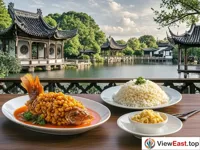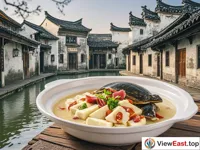









Introduction
Chinese culinary culture is extensive and profound. From the fertile black soil of the Northeast to the tropical charm of Hainan, from the plateaus of the west to the coastlines of the east, the dietary culture across China exhibits a rich array of regional characteristics. The diversity and unique flavors of Chinese cuisine not only satisfy the taste buds but also embody deep cultural significance.
China's Eight Major Cuisines
Chinese culinary culture is traditionally divided into eight major cuisines, each with its distinctive flavors and cooking techniques.
Sichuan Cuisine: Numbing and Spicy
Sichuan cuisine is known for its numbing and spicy flavors. Its unique seasoning and bold innovation have made it one of the most popular cuisines. Classic dishes such as Mapo Tofu and Kung Pao Chicken have captivated countless diners with their spicy and savory taste.
Shandong Cuisine: Fresh and Salty-Sweet
Shandong cuisine, originating from Shandong province, is famous for its fresh and salty-sweet flavors and refined cooking skills. Braised Pork Balls in Gravy and Sweet and Sour Yellow River Carp are well-known dishes in Shandong cuisine.
Cantonese Cuisine: Light and Delicious
Cantonese cuisine, from Guangdong, is admired for its light and delicious taste, focusing on the original flavors of the ingredients. White Cut Chicken and Steamed Seafood are examples of dishes that showcase the natural flavors of the ingredients.
Jiangsu Cuisine: Sweet and Delicate
Jiangsu cuisine, known for its sweet and delicate taste, is celebrated for its fine textures and exquisite presentation. Sweet and Sour Mandarin Fish and Yangzhou Fried Rice are delicacies in Jiangsu cuisine.
Fujian Cuisine: Sweet and Sour
Fujian cuisine, from Fujian province, specializes in cooking seafood with a balance of sweet and sour flavors. Buddha Jumps Over the Wall and Lychee Pork are representative dishes of Fujian cuisine.
Zhejiang Cuisine: Tender and Smooth
Zhejiang cuisine is noted for its tender and smooth texture and light, elegant taste. West Lake Vinegar Fish and Longjing Shrimp are classics in Zhejiang cuisine.
Hunan Cuisine: Sour and Tender
Hunan cuisine, representing Hunan province, is famous for its sour and tender flavors and diverse cooking techniques. Steamed Fish Head with Diced Hot Red Peppers and Western Hunan Salted Pork are signature dishes of Hunan cuisine.
Anhui Cuisine: Rich and Colorful
Anhui cuisine, from Anhui province, is characterized by its rich and colorful flavors, emphasizing the control of heat during cooking. Hairy Tofu and Stewed Turtle with Ham are representative dishes of Anhui cuisine.
The Deep Cultural Significance of Chinese Dietary Culture
Chinese dietary culture is not just about the combination of food but also a reflection of culture.
Festival Food Customs
Chinese festival food customs are rich and varied, such as dumplings for the Spring Festival, sweet rice balls for the Lantern Festival, and mooncakes for the Mid-Autumn Festival. Each type of food has its specific cultural meaning.
Food Therapy Culture
The culture of food therapy in China has a long history, emphasizing the relationship between food and health, and aiming to achieve health preservation through a reasonable diet.
Tea Culture
Tea culture is an important part of Chinese dietary culture. Tea tasting is not only a lifestyle but also a cultural cultivation.
Conclusion
Chinese dietary culture is the crystallization of the wisdom of the Chinese nation, showcasing the Chinese people's love for food and passion for life. Gaining an in-depth understanding of Chinese dietary culture allows us to appreciate not only the delicious taste of the food but also the charm of the culture.
Exploring Chinese dietary culture, we can learn how to transform ingredients into delicious dishes; studying Chinese cuisine, we can learn how to seek innovation and balance in cooking. The essence of Chinese dietary culture is not only the diversity of food but also the transmission of culture.